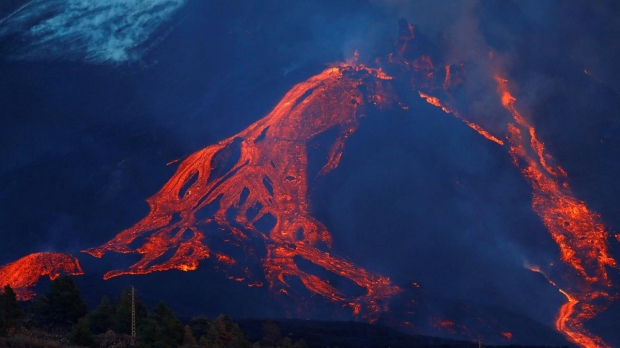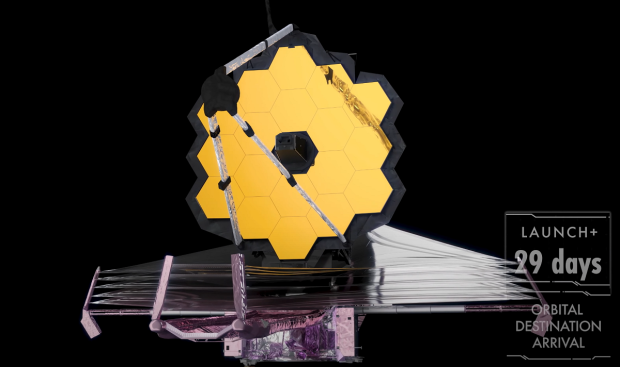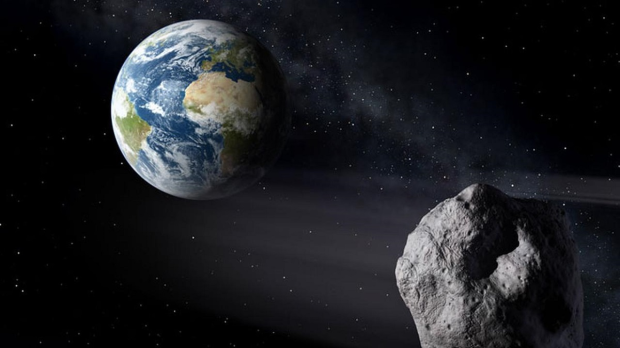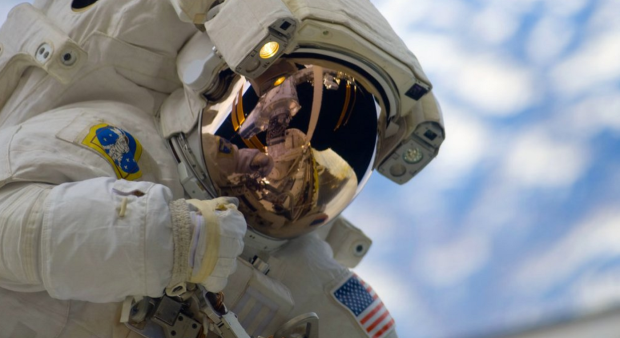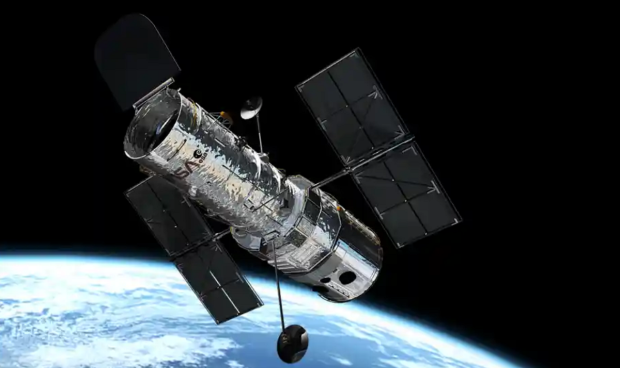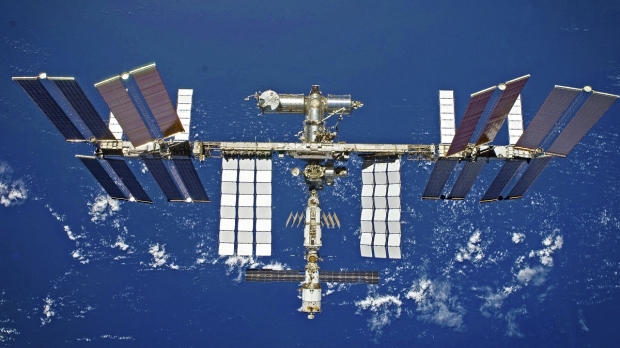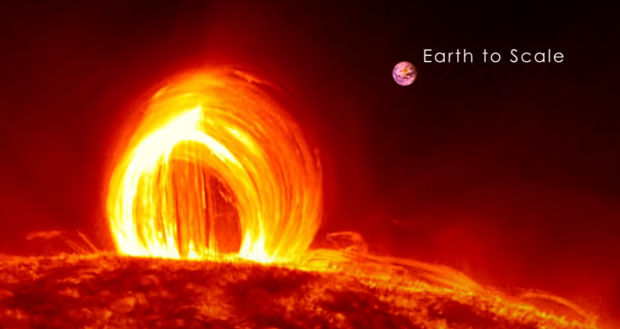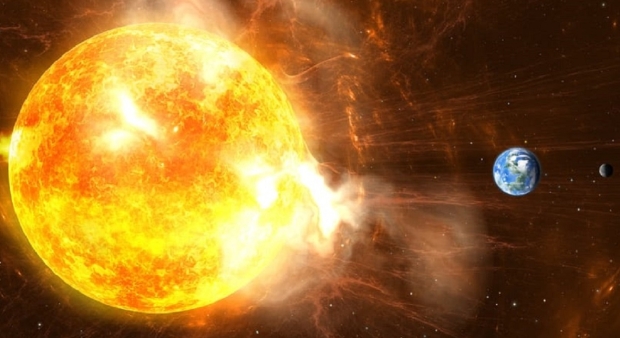Science, Space, Health & Robotics News - Page 249
Politician suggests dropping bombs on volcano that won't stop erupting
A Spanish politician suggested a solution for the seemingly never-stopping lava rivers that are spewing out of the La Palma volcano. The volcano has been erupting for 42 days.
Casimiro Curbelo, the president of the municipal council of La Gomera, an island that neighbors La Palma, said that the lava rivers could be diverted to new locations through bombing runs made by an airplane. Curbelo made the statement during a debate on the Canary Islands' Radio Faycan where he said, "Isn't there a plane that could fly and drop [a bomb]? It arrives, drops and boom. And it sends the lava in a different direction?" Adding, "Maybe it's madness, but I get the impression from a technological point of view that it should be tried."
This suggestion of using bombs to divert the flow of lava has been made before, and attempts have been made. Back in 1983, a team of engineers placed 900 pounds of explosives near a river of lava that was erupting from Mount Etna. The idea was to create a new trench for the lava to move into and divert its original course away from a nearby village.
Continue reading: Politician suggests dropping bombs on volcano that won't stop erupting (full post)
Watch Hubble's successor being unboxed before its terrifying launch
The successor to the famous Hubble Space Telescope has reached the spaceport where it will launch from, but before its launch, it's been unboxed.
No one is more terrified for the launch of the James Webb Space Telescope than NASA, the European Space Agency (ESA), and every individual that has worked on the project since its fruition more than 10 years ago. Now, the next-generation space telescope is nearing the end of its development and is going through its last checks before it's packed into an Ariane 5 rocket for its launch scheduled in December 2021.
Before everyone nervously watches the launch of the extremely expensive Hubble successor, the European Space Agency has posted a video that showcases Webb being unboxed in the cleanroom at Europe's Spaceport. The video shows Webb being transported from its ship onboard a truck to the facility, where it's then slowly and meticulously unboxed. Webb will keep the world on edge for 29 harrowing days, and to find out why check out this link here.
Continue reading: Watch Hubble's successor being unboxed before its terrifying launch (full post)
NASA drops warning for this massive asteroid fast-approaching Earth
Reports indicate that NASA has warned of an asteroid estimated to be around the size of the Eiffel Tower approaching Earth.
The asteroid is dubbed 4660 Nereus and is deemed "potentially hazardous", which means that its orbit brings it within 4,647,790 miles of Earth and has a diameter of more than 460 feet. The space agency predicts that 4660 Nereus will pass within 2.4 million miles on December 11 and has a diameter of 1082.68 feet. However, the agency says that the asteroid doesn't pose a threat of impact to Earth.
Additionally, The Independent reports that the asteroid is predicted to make 12 more close approaches to Earth within the coming decades, with the closest being on February 14, 2060, when it will come 745,645 miles away from Earth. For a visual comparison of how close that is to Earth, the Moon is located around 239,000 miles from Earth. If you are interested in finding out if an asteroid has hit Earth before, check out a NASA expert answering that very question here.
Continue reading: NASA drops warning for this massive asteroid fast-approaching Earth (full post)
Star 20 times the mass of the Sun explodes, creates this insane nebula
NASA is celebrating Nebula November, and the space agency is revisiting all of the incredible nebulae that have been observed throughout our Milky Way galaxy.
One particular jaw-dropping image captured by NASA and the European Space Agency's Hubble Space Telescope is of the Veil Nebula. NASA Hubble Space Telescope used its Wide Field Camera 3 instrument to observe the Veil Nebula that's located around 2,100 light-years away from Earth within the constellation Cygnus. NASA explains that the Veil Nebula is a result of a star that's estimated to have been 20 times the mass of the Sun exploding in a violent supernova around 10,000 years ago.
NASA writes that the star lived fast and died young, and when its life came to an end, it released a large amount of energy into the space around it. The shockwaves from the explosion and the debris "sculpted the Veil Nebula's delicate tracery of ionized gas - creating a scene of surprising astronomical beauty." Ionized oxygen can be seen in the blue colors, ionized hydrogen and ionized nitrogen can be seen in the reds. If you are interested in reading more about the Veil Nebula, check out this link here.
Continue reading: Star 20 times the mass of the Sun explodes, creates this insane nebula (full post)
NASA astronaut explains how he thought he was going to drown in space
A former NASA astronaut has explained how he thought he would be the first astronaut to ever drown during a spacewalk.
Former NASA astronaut Garret Reisman took to Twitter to give an "astronaut tip" where he said that all astronauts should make sure their bite valve is firmly attached to your water bag straw. Looking at NASA documentation regarding astronaut suits and helmets, spacesuits contain a drinking bag of water that has a straw running into the astronaut's mouth. Reisman goes on to say that during a spacewalk, he saw his water bag floating inside of his helmet.
Here's what Reisman said, "Astronaut Tip #217: Make sure your bite valve is firmly attached to your water bag straw. When I saw mine float by INSIDE my helmet I was less than thrilled at the thought of becoming the first astronaut to drown during a spacewalk." Reisman added, "Fortunately, the surface tension proved to be enough to keep the majority of the water in the bag."
Continue reading: NASA astronaut explains how he thought he was going to drown in space (full post)
NASA posts wild nebula image, 'one of the most unusual' in our galaxy
NASA is celebrating Nebula November and is going back through some of the images taken by the Hubble Space Telescope of the crazy nebulas that have been found.
To kick this week off strongly, the Hubble Twitter account has posted an image of the Red Rectangle Nebula that is formally called HD 44179. NASA explains on its website that at the center of this nebula is a dying binary star system that has been shedding its outer layers for around 14,000 years. NASA continued to explain that the unusual shape is likely due to "a thick dust torus which pinches the otherwise spherical outflow into tip-touching cone shapes."
So, what about its color? Researchers are yet to understand the colors of the nebula fully, but speculation has led scientists towards assuming that the color may be provided by hydrocarbon molecules that "may be the building blocks for organic life", writes NASA. The Red Rectangle nebula is positioned 2,300 light-years away from Earth within the Unicorn constellation. If you are interested in learning more about this strange nebula, check out this link here.
Continue reading: NASA posts wild nebula image, 'one of the most unusual' in our galaxy (full post)
NASA officially delays launch of next astronauts headed to the ISS
NASA announced on Sunday that the launch for SpaceX Crew-3 that is headed to the International Space Station (ISS) has been delayed yet again.
Originally, NASA and SpaceX had planned to swap over the Crew-2 astronauts onboard the ISS with the Crew-3 astronauts before Crew-2 departed the station, but that now isn't going to happen as the space agency has changed its plans for how the two teams will swap positions. NASA has decided to send the Crew-2 astronauts back down to Earth before the arrival of the Crew-3 astronauts. Crew-2 is scheduled to return back to Earth on November 8 at 2:05 pm ET.
Following the return of the Crew-2, SpaceX will launch Crew-3 on the back of its Falcon 9 rocket, marking the third long-duration crew mission to the ISS. That launch is scheduled for November 10, and at the moment, SpaceX is estimating that there is 80% of the weather will be favorable for launch, according to a recent tweet from the space transportation company. If you are interested in reading more about this story or would like to learn more about the launch, check out this link here.
Continue reading: NASA officially delays launch of next astronauts headed to the ISS (full post)
NASA expert answers 'when was the last time an asteroid hit Earth?'
A new video that is part of NASA's "We Asked a NASA Expert" series tackles the question, "When was the last time an asteroid hit Earth?"
NASA asteroid expert Marina Brozovic explains that the last time an asteroid hit Earth really depends on if you are asking about small or large impacts. Brozovic explains that Earth is bombarded by small asteroids all of the time, but luckily for humans on the surface, these small space rocks usually burn up in the atmosphere on their way towards the ground.
As for large asteroids that can cause impact craters that span miles in width, Brozovic explains that the last time such an event happened was millions of years ago. Large asteroid impacts are considered to be "rare", but that doesn't mean they aren't dangerous, just unlikely. NASA and other space bodies around the world are tracking more than 90% of these large asteroids that could one day pose a danger to Earth. For more information on asteroids, check out this link here.
Continue reading: NASA expert answers 'when was the last time an asteroid hit Earth?' (full post)
Three blasts from the Sun to hit Earth very soon, one is 'cannibal'
Three bursts from the Sun have been observed, and these bursts are heading towards Earth. Officials expect an impact very soon.
The Sun can launch what scientists call coronal mass ejections (CME) from its surface, which are large expulsions of plasma and magnetic field that usually come after a sunspot, knots in the Sun's magnetic field, erupt. Officials at the NOAA Space Weather Prediction Center confirmed that on November 1 and November 2, a sunspot called AR2887 released two of these CMEs, which was followed by a third CME from sunspot AR2891.
The first two blasts from the Sun are moving much slower than the third, as the third ate its way through the first and second. All three of the CMEs are on track to hit Earth, with arrival times for the large CME to be on November 3. Officials also warned that the CME impact might produce minor to moderate geomagnetic storms in Earth's upper atmosphere that can cause disruptions for power grids, satellite orientations, GPS communications, and more. On a more positive note, the CME impact can also cause beautiful auroras, such as this one.
Continue reading: Three blasts from the Sun to hit Earth very soon, one is 'cannibal' (full post)
Officials confirm blast from the Sun will hit Earth soon, date found
The NOAA Space Weather Prediction Center recently warned multiple coronal mass ejections (CME) are heading directly towards Earth.
Following up on yesterday's story, the NOAA Space Weather Prediction Center has published a new update regarding the incoming CMEs. For those that aren't aware of the multiple CMEs heading towards Earth, on 01-02 November, the Sun erupted several CMEs from its southwest area, one associated with a C4 solar flare and another related to an M1 flare. NOAA originally predicted that the impacts might cause a G1 (minor) geomagnetic storm, but now the official prediction center has updated its forecast.
According to the recent update published to the official NOAA website, "The G1 (Minor) Geomagnetic Storm Watch for 04 Nov has been upgraded to a G2 (Moderate) Geomagnetic Storm Watch. The G1 (Minor) Geomagnetic Storm Watch for 03 November remains in effect." It should be noted that these impacts pose no danger to humans on the surface of Earth but can cause disruptions for satellites, GPS communications, and radio communications. Additionally, CME impacts can cause auroras to appear in the sky. To learn more about CMEs, check out this link here.
Continue reading: Officials confirm blast from the Sun will hit Earth soon, date found (full post)


